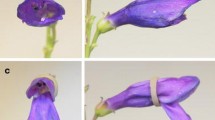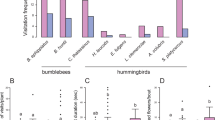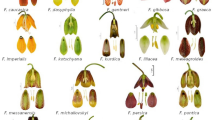Abstract
The pollination syndrome concept implies that flowers evolved with particular sets of characteristics, such as colors, shapes, orientations, and rewards, as a means of attracting pollinators. However, these traits may have also evolved to deter unwanted visitors. The North American genus Penstemon exhibits a great floral diversity that is mainly associated with bumblebee and hummingbird pollination. Evolutionary shifts from insect pollination to hummingbird pollination have occurred in Penstemon repeatedly, but some species maintain mixed-pollination systems and intermediate floral traits between bee- and hummingbird-pollination modes. The apparently intermediate floral traits of species with mixed-pollination systems might be potentially acting to deter bumblebee foragers. Then, bird-flower traits might be selected with increased hummingbird visitation over evolutionary time might, resulting in specialization to and the evolution of floral traits present in hummingbird-pollinated species. Here, we modified bee-pollination floral traits in Penstemon gentianoides with a mixed pollination system, to resemble hummingbird-pollination traits, and measured the effects of trait modification on bumblebee foraging behavior and plant female reproductive fitness. Our results showed that reduction in the width of the corolla tube and the absence of the corolla lip negatively affects bumblebee visitation and their efficiency as pollinators, and that the synergistic interaction of both traits enhanced the “anti-bee” effect. We conclude that acquisition of floral traits that resemble those of hummingbird-pollination enables Penstemon plant species to deter bumblebee visits.




Similar content being viewed by others
References
Aguilar R, Martén-Rodríguez S, Avila Sakar G, Ashworth L, Lopezaraiza Mikel M, Quesada M (2015) A global review of pollination syndromes: a response to Ollerton et al. 2015. J Poll Ecol 17:126–128
Aigner PA (2001) Optimality modeling and fitness trade-offs: when should plants become pollinator specialists? Oikos 95:177–184
Armbruster WS (1988) Multilevel comparative analysis of the morphology, function, and evolution of Dalechampia blossoms. Ecology 69:1746–1761
Armbruster WS, Fenster CB, Dudash MR (2000) Pollination “principles” revisited: specialization, pollination syndromes, and the evolution of flowers. The Scandinavian Association For Pollination Ecology Honours Knut Faegri 39:179–200
Baker HG (1963) Evolutionary mechanisms in pollination biology. Science 139:877–883
Barrett SCH, Harder LD (1996) Ecology and evolution of plant mating. Tree 11:73–79
Bradshaw HD, Schemske DW (2003) Allele substitution at a flower colour locus produces a pollinator shift in monkeyflowers. Nature 426:176–178
Burkle LA, Runyon JB (2017) The smell of environmental change: using floral scent to explain shifts in pollinator attraction. Appl Plant Sci 5:1600123
Campbell DR, Waser NM, Price MV (1996) Mechanisms of hummingbird-mediated selection for flower width in Ipomopsis aggregata. Ecology 77:1463–1472
Castellanos MC, Wilson P, Thomson JD (2003) Pollen transfer by hummingbirds and bumblebees, and the divergence of pollination modes in Penstemon. Evolution 57:2742–2752
Castellanos MC, Wilson P, Thomson JD (2004) ‘Anti-bee’ and ‘pro-bird changes during the evolution of hummingbird pollination in Penstemon flowers. J Evol Biol 17:876–885
Cresswell JE, Galen C (1991) Frequency-dependent selection and adaptive surfaces for floral character combinations: the pollination of Polemonium viscosum. Am Nat 138:1342–1353
Darwin C (1862) On the two forms, or dimorphic condition, in the species of Primula, and on their remarkable sexual relations. J Proc Linn Soc Bot 6:77–96
Duennes MA, Lozier JD, Hines HM, Cameron SA (2012) Geographical patterns of genetic divergence in the widespread Mesoamerican bumble bee Bombus ephippiatus (Hymenoptera: Apidae). Mol Phylogenet Evol 64:219–231
Dukas R (1998) Cognitive ecology: the evolutionary ecology of information processing and decision-making. University of Chicago Press
Faegri K, van der Pijl L (1979) The principles of pollination ecology, 3rd edn. Pergamon Press, Oxford
Feinsinger P (1987) Approaches to nectarivore-plant interactions in the New World. Rev Chil Hist Nat 60:285–319
Fenster CB, Dudash MR (2001) Spatiotemporal variation in the role of hummingbirds as pollinators of Silene virginica. Ecology 82:844–851
Fenster CB, Armbruster WS, Wilson P, Dudash MR, Thomson JD (2004) Pollination syndromes and floral specialization. Annu Rev Ecol Evol Syst 35:375–403
Fenster CB, Reynolds RJ, Williams CW, Makowsky R, Dudash MR (2015) Quantifying hummingbird preference for floral trait combinations: the role of selection on trait interactions in the evolution of pollination syndromes. Evolution 69:1113–1127
Fleming TH, Geiselman C, Kress WJ (2009) The evolution of bat pollination: a phylogenetic perspective. Ann Bot 104:1017–1043
Galen C, Cuba J (2001) Down the tube: pollinators, predators, and the evolution of flower shape in the alpine skypilot, Polemonium viscosum. Evolution 55:1963–1971
Gegear RJ, Burns JG (2007) The birds, the bees, and the virtual flowers: can pollinator behavior drive ecological speciation in flowering plants? Am Nat 170:551–566
Gegear RJ, Burns R, Swoboda-Battarai KA (2017) “Hummingbird” floral traits interact synergistically to discourage visitation by bumble bee foragers. Ecology 98:489–499
Gervasi DDL, Schiestl FP (2017) Real-time divergent evolution in plants driven by pollinators. Nat Commun 8:14691
Gomez JM, Bosch J, Perfectti F, Fernández JD, Abdelaziz M, Camacho JPM (2008) Spatial variation in selection on corolla shape in a generalist plant is promoted by the preference patterns of its local pollinators. Proc R Soc B 275:2241–2249
Herrera CM (1995) Microclimate variation and individual variation in pollinators: flowering plants are more than their flowers. Ecology 76:1516–1524
Herrera CM (1996) Floral traits and plant adaptation to insect pollinators: a devil’s advocate approach. In: Barrett SCH, Lloyd DG (eds) Floral biology. Chapman and Hall, New York, pp 65–87
Herrera CM, Pellmyr O (2009) Plant animal interactions: an evolutionary approach. John Wiley & Sons
Horvitz CC, Schemske DW (2002) Spatiotemporal variation in insect mutualists of a Neotropical herb. Ecology 71:1085–1097
Johnson SD, Hargreaves AL, Brown M (2006) Dark, bitter-tasting nectar functions as a filter of flower visitors in a bird-pollinated plant. Ecology 87:2709–2716
Kay KM, Reeves PA, Olmstead RG, Schemske DW (2005) Rapid speciation and the evolution of hummingbird pollination in Neotropical Costus subgenus Costus (Costaceae): evidence from nrDNA ITS and ETS sequences. Am J Bot 92:1899–1910
Klinkhamer PG, de Jong TJ (1993) Attractiveness to pollinators: a plant’s dilemma. Oikos 66:180–184
Lange RS, Scott PE (1999) Hummingbird and bee pollination of Penstemon pseudospectabilis. J Torrey Bot Soc 126:99–106
Lara C (2006) Temporal dynamics of flower use by hummingbirds in a highland temperate forest in Mexico. Ecoscience 13:23–29
Lara C, Ornelas JF (2008) Pollination ecology of Penstemon roseus (Plantaginaceae), an endemic perennial shifted toward hummingbird specialization? Plant Syst Evol 271:223–237
Martén-Rodríguez S, Almarales-Castro A, Fenster CB (2009) Evaluation of pollination syndromes in Antillean Gesneriaceae: evidence for bat, hummingbird and generalized flowers. J Ecol 97:348–359
Martin NH, Sapir Y, Arnold ML (2008) The genetic architecture of reproductive isolation in Louisiana irises: pollination syndromes and pollinator preferences. Evolution 62:740–752
Mast AR, Milton EF, Jones EH, Barker RM, Barker WR, Weston PH (2012) Time-calibrated phylogeny of the woody Australian genus Hakea (Proteaceae) supports multiple origins of insect-pollination among bird-pollinated ancestors. Am J Bot 99:472–487
Møller AP (1995) Bumblebee preference for symmetrical flowers. Proc Natl Acad Sci U S A 92:2288–2292
Navarro-Pérez ML, López J, Fernández-Mazuecos M, Rodríguez-Riaño T, Vargas P, Ortega- Olivencia A (2013) The role of birds and insects in pollination shifts of Scrophularia (Scrophulariaceae). Mol Phylogenet Evol 69:239–254
Newstrom L, Robertson AW (2005) Progress in understanding pollination systems in New Zealand. N Z J Bot 43:1–59
Ojeda DI, Valido A, Fernández de Castro AG, Ortega-Olivencia A, Fuertes-Aguilar J, Carvalho JA, Santos-Guerra A (2016) Pollinator shifts drive petal epidermal evolution on the Macaronesian Islands bird-flowered species. Biol Lett 12:20160022
Olesen JM, Dupont YL, Ehlers BK, Hansen DM (2007) The openness of a flower and its number of flower-visitor species. Taxon 56:729–736
Ollerton J, Johnson SD, Cranmer L, Kellie S (2003) The pollination ecology of an assemblage of grassland asclepiads in South Africa. Ann Bot 92:807–834
Ollerton J, Killick A, Lamborn E, Watts S, Whiston M (2007) Multiple meanings and modes: on the many ways to a generalist flower. Taxon 56:717–728
Ollerton J, Alarcón R, Waser NM, Price MV, Watts S, Cranmer L, Hingston A, Peter CI, Rotenberry J (2009) A global test of the pollination syndrome hypothesis. Ann Bot 103:1471–1480
Ollerton J, Rech AR, Waser NM, Price MV (2015) Using the literature to test pollination syndromes––some methodological cautions. J Pollinat Ecol 16:119–125
Ollerton J, Liede-Schumann S, Endress ME, Meve U, Rech AR, Shuttleworth A, Keller HA et al (2018) The diversity and evolution of pollination systems in large plant clades: Apocynaceae as a case study. Ann Bot 00:00–00
Ornelas JF, Lara C (2009) Nectar replenishment and pollen receipt interact in their effects on seed production of Penstemon roseus. Oecologia 160:675–685
Pérez F, Arroyo MT, Medel R, Hershkovitz MA (2006) Ancestral reconstruction of flower morphology and pollination systems in Schizanthus (Solanaceae). Am J Bot 93:1029–1038
R Core Team (2014) A language and environment for statistical computing. R Foundation for Statistical Computing, Vienna http://www.R-project.org/. Accessed 8 April 2018
Reid WH, Sensiba P, Freeman E (1988) A mixed pollination system in Penstemon pseudospectabilis. M.E. Jones. (Scrophulariaceae). Great Basing Nat 48:489–494
Rivest SA, Austen EJ, Forrest JRK (2017) Foliage affects colour preference in bumblebees (Bombus impatiens): a test in a three-dimensional artificial environment. Evol Ecol 31:435–446
Rodríguez-Gironés MA, Sun S, Santamaría L (2015) Passive partner choice through exploitation barriers. Evol Ecol 29:323–340
Rodríguez-Rodríguez MC, Jordano P, Valido A (2013) Quantity and quality components of effectiveness in insular pollinator assemblages. Oecologia 173:179–190
Rosas-Guerrero V, Aguilar R, Martén-Rodríguez S, Ashworth L, Lopezaraiza-Mikel M, Bastida JM, Quesada M (2014) A quantitative review of pollination syndromes: do floral traits predict effective pollinators? Ecol Lett 17:388–400
Salas-Arcos L, Lara C, Ornelas F (2017) Reproductive biology and nectar secretion dynamics of Penstemon gentianoides (Plantaginaceae): a perennial herb with a mixed pollination system? PeerJ 5:e3636
Schemske DW, Bradshaw HD (1999) Pollinator preference and the evolution of floral traits in monkeyflowers (Mimulus). Proc Natl Acad Sci U S A 96:11910–11915
Schemske DW, Horvitz CC (1984) Variation among floral visitors in pollination ability: a precondition for mutualism specialization. Science 225:519–521
Scopece G, Cozzolino S, Johnson SD, Schiestl F (2010) Pollination efficiency and the evolution of specialized deceptive pollination systems. Am Nat 175:98–105
Serrano-Serrano ML, Rolland J, Clark JL, Salamin N, Perret M (2017) Hummingbird pollination and the diversification of angiosperms: an old and successful association in Gesneriaceae. Proc R Soc B 284:20162816
Stebbins GL (1970) Adaptive radiation of reproductive characteristics in angiosperms. I: pollination mechanisms. Annu Rev Ecol Syst 1:307–326
Steiner KE (1998) The evolution of beetle pollination in a South African orchid. Am J Bot 85:1180–1193
Straw RM (1956) Floral isolation in Penstemon. Am Nat 90:47–53
Strelin MM, Benitez-Vieyra S, Ackermann M, Cocucci A (2016) Flower reshaping in the transition to hummingbird pollination in Loasaceae subfam. Loasoideae despite absence of corolla tubes or spurs. Evol Ecol 30:401–417
Temeles EJ, Rankin AG (2000) Effect of the lower lip of Monarda didyma on pollen removal by hummingbirds. Can J Bot 78:1164–1168
Thomson JD, Wilson P (2008) Explaining evolutionary shifts between bee and hummingbird pollination: convergence, divergence and directionality. Int J Plant Sci 169:23–38
Thomson JD, Wilson P, Valenzuela M, Malzone M (2000) Pollen presentation and pollination syndromes, with special reference to Penstemon. Plant Species Biol 15:11–29
Toon A, Cook LG, Crisp MD (2014) Evolutionary consequences of shifts to bird-pollination in the Australian pea-flowered legumes (Mirbelieae and Bossiaeeae). BMC Evol Biol 14:43
Villers RL, Rojas GF, Tenorio LP (2006) Guía Botánica del Parque Nacional Malinche Tlaxcala-Puebla. Univ. Nacional Autónoma de México, México
Waser NM, Chitka L, Price MV, Williams NM, Ollerton J (1996) Generalization in pollination systems and why it matters. Ecology 77:1043–1060
Waser NM, CaraDonna PJ, Price MV (2018) Atypical flowers can be as profitable as typical hummingbird flowers. Am Nat 192:644–653
Wessinger CA, Hileman LC, Rausher MD (2014) Identification of major quantitative trait loci underlying floral pollination syndrome divergence in Penstemon. Philos Tran R Soc B 369:20130349
Wessinger CA, Freeman CC, Mort ME, Rausher MD, Hileman LC (2016) Multiplexed shotgun genotyping resolves species relationships within the North American genus Penstemon. Am J Bot 103:912–922
Wilson P, Jordan EA (2009) Hybrid intermediacy between pollination syndromes in Penstemon, and the role of nectar in affecting hummingbird visitation. Botany 87:272–282
Wilson P, Castellanos MC, Hogue JM, Thomson JD, Armbruster SW (2004) A multivariate search for pollination syndromes among Penstemons. Oikos 104:345–361
Wilson P, Castellanos MC, Wolfe AD, Thomson JD (2006) Shifts between bee and bird pollination in Penstemon. In: Waser NM, Ollerton J (eds) Plant-pollinator interactions, from specialization to generalization. The University of Chicago Press, Chicago, pp 47–68
Wilson P, Wolfe AD, Armbruster WS, Thomson JD (2007) Constrained lability in floral evolution: counting convergent origins of hummingbird pollination in Penstemon and Keckiella. New Phytol 176:883–890
Wolfe AD, Randle CP, Datwyler SL, Morawetz JJ, Arguedas N, Diaz J (2006) Phylogeny, taxonomic affinities, and biogeography of Penstemon (Plantaginaceae) based on ITS and cpDNA sequence data. Am J Bot 93:1699–1713
Zung JL, Forrest JR, Castellanos MC, Thomson JD (2015) Bee-to bird-pollination shifts in Penstemon: effects of floral-lip removal and corolla constriction on the preferences of free-foraging bumble bees. Evol Ecol 29:341–354
Acknowledgements
We thank M. Luna, D. López, I. Morales, V. Mendiola, and L. Salinas for field assistance and the staff of the La Malinche National Park (Coordinación General de Ecología) for allowing the access to their facilities. Four anonymous reviewers provided useful comments on previous versions of the manuscript. Permission to conduct our fieldwork was granted by the Mexican government (SEMARNAT, FAUT-0296). This work constitutes partial fulfillment of LCSA’s doctorate at the Universidad Autónoma de Tlaxcala.
Funding
The Consejo Nacional de Ciencia y Tecnología (CONACyT) provided financial support in the form of a scholarship (248118) to the first author.
Author information
Authors and Affiliations
Corresponding author
Additional information
Communicated by: Ana M Martin González
Rights and permissions
About this article
Cite this article
del Carmen Salas-Arcos, L., Lara, C., Castillo-Guevara, C. et al. “Pro-bird” floral traits discourage bumblebee visits to Penstemon gentianoides (Plantaginaceae), a mixed-pollinated herb. Sci Nat 106, 1 (2019). https://doi.org/10.1007/s00114-018-1595-4
Received:
Revised:
Accepted:
Published:
DOI: https://doi.org/10.1007/s00114-018-1595-4




